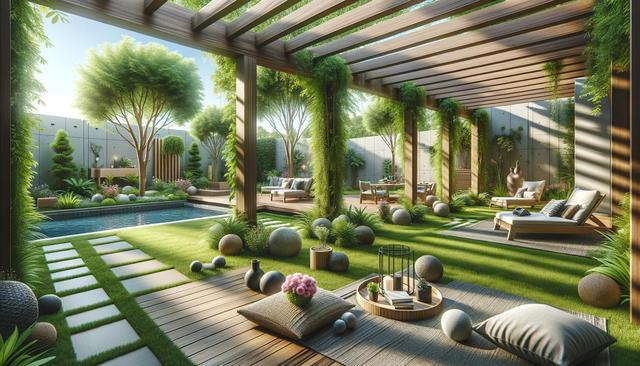
Create a Peaceful and Practical Outdoor Space with Smart Landscaping
Assessing Your Outdoor Space
Before diving into a landscaping project, it’s essential to evaluate the current state of your outdoor area. Consider how the space is used, the size and shape of your yard, and the existing conditions such as sunlight, soil type, and drainage. Understanding these elements will help you make informed decisions and avoid costly mistakes down the line. Ask yourself a few key questions:
- What is the primary purpose of the space—relaxation, entertainment, gardening, or play?
- How much maintenance are you willing to commit to?
- Are there any problem areas, such as poor drainage or overly shaded spots?
Take measurements and create a rough sketch of your yard layout. This will serve as a useful reference as you begin selecting plants, materials, and features for your landscape design. A good assessment ensures that your choices align with the conditions and your lifestyle needs, setting a solid foundation for the transformation.
Choosing the Right Plants
Plants play a central role in setting the tone of your outdoor space. Whether you want a lush, tropical retreat or a minimalist garden, the plant selection should reflect your style and the environment. Start by choosing native or climate-appropriate plants, as these typically require less water and maintenance. This approach also supports local ecosystems and wildlife.
Consider integrating a mix of plant types to add texture and visual interest:
- Evergreens for year-round structure
- Perennials for seasonal color
- Grasses for movement and softness
- Ground covers to reduce erosion and weeds
Spacing and placement are equally important. Avoid overcrowding plants and ensure they have room to grow. Place taller plants towards the back or center (depending on the layout) and shorter ones near edges or pathways. Choosing the right plants and placing them thoughtfully can create a serene and balanced outdoor atmosphere.
Incorporating Hardscaping for Functionality
Hardscaping elements like patios, walkways, retaining walls, and decks can add both functionality and aesthetic appeal to your yard. These features define areas for socializing, dining, and relaxing, while also managing elevation changes and improving accessibility. When selecting materials, consider durability, maintenance, and how well they blend with your home’s architecture.
Popular hardscaping elements include:
- Stone or paver patios for dining and lounging
- Gravel or concrete paths for easy movement
- Wooden decks for raised seating areas
- Decorative retaining walls for managing slopes
Blending hardscape and softscape (plants and greenery) elements is key to creating a cohesive look. For example, pair a stone patio with surrounding flower beds or use climbing plants on a trellis near a seating area. Thoughtful hardscaping choices enhance both the usability and visual appeal of your outdoor space.
Creating Zones for Different Activities
Dividing your outdoor space into zones helps maximize both comfort and functionality. Each area can serve a dedicated purpose, such as dining, play, gardening, or quiet reflection. This zoning approach makes even small yards feel larger and more organized. Use landscaping features like hedges, planters, or changes in material to define these spaces subtly.
Common outdoor zones include:
- Dining areas with a table, chairs, and shade
- Lounge zones with seating, cushions, and soft lighting
- Gardening corners with raised beds and tool storage
- Play areas with open lawn or natural features like logs and boulders
Ensure each zone has a clear purpose and is easy to access. Consider the flow between areas and how people will move through the space. Adding focal points, such as a water feature or sculpture, can also help anchor each zone and tie the design together. A well-zoned yard supports multiple activities while maintaining a serene and uncluttered feel.
Enhancing Comfort with Lighting and Accessories
To fully enjoy your outdoor space at all times of day, consider incorporating lighting and outdoor accessories that boost comfort and ambiance. Lighting extends the usability of your yard into the evening and adds safety to walkways and entry points. Choose energy-efficient options like solar or LED fixtures and use a mix of lighting types for layered effects.
Ideas for outdoor lighting include:
- String lights over seating or dining areas
- Pathway lights for safe navigation
- Uplighting to highlight trees or architectural features
- Lanterns or candles for a cozy glow
Accessories such as cushions, rugs, planters, and shade structures can further personalize your outdoor retreat. Choose weather-resistant materials that withstand the elements while adding style. Thoughtful additions like a bird feeder, wind chimes, or a small fountain can bring sound and motion, deepening the sense of tranquility. These finishing touches transform your yard into an inviting extension of your home.
Conclusion: Designing a Space That Reflects You
Creating a serene and practical outdoor space is an achievable goal with thoughtful landscaping choices. By assessing your yard, selecting compatible plants, incorporating functional hardscaping, zoning for various uses, and enhancing comfort with lighting and accessories, you can build an outdoor retreat that aligns with your lifestyle. Whether you’re aiming for relaxation, entertainment, or a mix of both, a well-designed landscape turns your outdoor area into a space you’ll enjoy for years to come.


